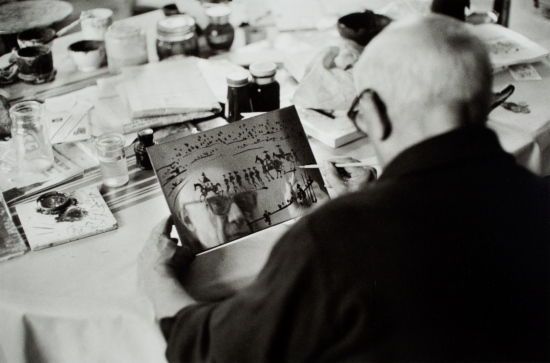Different management and new exhibitions at Barcelona’s Picasso Museum
The Picasso Museum of the Catalan capital will no longer be solely run by the municipality. From the 1st of January 2014, it will be managed by the public-private Picasso Museum Foundation. This will be the beginning of a new era for the museum, which is set to focus on the conservation, study and development of its own artistic heritage, by launching the ‘Centre de Referència Picassiana on-line’, dedicated to researching and teaching Picasso around the world. The managers of the museum also wish to delve into the influence of Picasso on contemporary art. Such an idea is at the core of the next exhibition dedicated to the illustrious painter: Post-Picasso: Contemporary Artists' Response to His Art, held from the 7th of March to the 29th of June, 2014.

Barcelona (ACN).- The Picasso Museum Foundation, created last September, will take over the management of the facilities from the 1st of January 2014. The museum will no longer be solely run by the municipality, and it will be managed by this public-private foundation. This will be the beginning of a new era for Barcelona’s Picasso Museum, which is set to focus on the conservation, study and development of its own artistic heritage, by “strengthening the teaching guidelines” of its Education Department, launching the future ‘Centre de Referència Picassiana on-line’ (dedicated to researching and teaching Picasso around the world) and delving into the influence of Picasso on contemporary art. Such an idea is at the core of the next exhibition dedicated to the illustrious painter: Post-Picasso: Contemporary Artists' Response to His Art, held from the 7th of March to the 29th of June, 2014. Next year, visitors of the museum will also be able to see the collection of works donated by David Douglas Duncan (October, 2nd / January 15th, 2015), who took several photos of the Spanish artist, revealing the creative process behind some of his works. The museum released a new schedule for next year. From January 2014 onwards, it will be open from 9 in the morning to 7 in the evening.
“The City Council has not, in any case, left the museum” stated Jaume Ciurana, who is Barcelona’s Councilman for Culture. In fact, members of the City Council still have pre-eminent positions within the foundation (chaired by the Mayor of Barcelona, Xavier Trias) and the Executive Committee (chaired by Ciurana himself). The museum will keep its CFO, Palmira Balagué, and its Director Bernardo Naniad-Romero, both appointed in 2012.
According to Jaume Ciurana, the change is aiming towards “a greater connection with civil society and a greater flexibility for some of the daily proceedings”. In other words, the challenge is to improve both the equipment and the dialogue with people in Barcelona, Catalonia, and the art world in general, said Ciurana.
Researching and teaching Picasso around the world
With much enthusiasm, the Vice-President of the Foundation, Joan Oliveres, described the many objectives set for the new era. He said “no one could hide” that the ultimate goal of the new management formula was centred on two axes: first, on “increasing the funds and their value”, and second on “improving the role of research and studying everything related to the world of Picasso”.
Among the immediate objectives are also “strengthening” the teaching guidelines of the Education Department, launching the future ‘Centre de Referència Picassiana on-line’ (dedicated to researching and teaching Picasso around the world) and creating a new annual cycle of conferences 'Conferència magistral Jaume Sabartés', which will start in 2014 with Elizabeth Cowling’s conference ‘Querido Sabartés: Jaume Sabartés vist per Picasso’ (Sabartés seen by Picasso). Sabartés, a Catalan artist and poet, became close friends with Picasso as well as his personal assistant. He organised some of his exhibitions and donated many of Picasso’s works to Barcelona’s museum, works which are to this day at the core of the museum collections.
Delving into Picasso’s influence on contemporary artists
In line with the main objectives targeted by Ciurana, the exhibitions programmed will explore the collections of the museum but also delve “further into the importance Picasso has had on contemporary artists from the five continents”.
Such intentions are reflected in the main temporary exhibition of the year, held from the 7th of March to the 29th of June, under the name Post-Picasso: Contemporary Artists' Response to His Art. This exhibition will be dedicated to the influence Picasso has had on many contemporary artists from all around the world. Organized by the famous Curator Michael FitzGerald, it will display a wide array of works by artists such as Chéri Samba (Democratic Republic of Congo), Guillermo Kuitca (Argentina), Fred Wilson (USA) or M. F. Husain and Atul Dodiya (India).
Picasso and Barcelona
As usual, there will be other exhibitions held for shorter periods of time. These will display the museum’s collection of works in various ways. 'Els paisatges de Barcelona' (The landscapes of Barcelona, May, 29th /September, 14th) show a series of Picasso early works, paintings and drawings portraying Barcelona city as well as the surrounding coast.
The Picasso Museum has decided to celebrate its 50th anniversary (1963-2013) by dedicating three exhibitions to its history. While the first two exhibitions took place earlier this year, the last one will be held in 2014 (January, 16th /April, 27th), and will explore all 79 exhibitions which have been organised since 1963.
Finally, visitors of the museum will also be able to see the second part of the collection of works donated by David Douglas Duncan (October, 2nd / January 15th, 2015), an American photojournalist and close friend of Picasso, who took several photos of the Spanish artist. This exhibition will display all 163 photos Duncan gave to the museum. In a similar way to documentaries, such works reveal the creative process behind some of Picasso’s works.